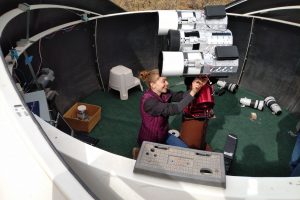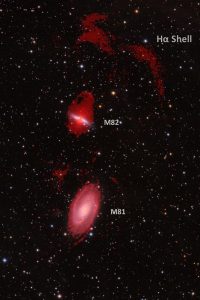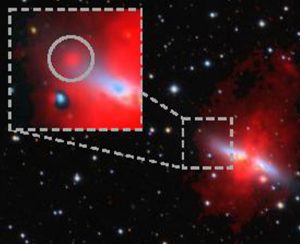By James Shelton, with notes from Meaghan MacSween

Deborah Lokhorst assembling the pathfinder version of the upgrade to the Dragonfly Telephoto Array with specialized filters to detect faint emission from extragalactic gas. Credit: Bob Abraham.
The Dragonfly telescope is undergoing a metamorphosis.
For the past decade, the Dragonfly Telephoto Array — designed by The University of Toronto’s Roberto Abraham and Yale’s Pieter van Dokkum — has conducted groundbreaking science by detecting faint starlight within dimly lit parts of the night sky. The telescope uses clusters of telephoto lenses to create images, much the way a dragonfly’s eyes gather visual data.
The telescope has spotted previously unseen “fluffy” galaxies, diffuse dwarf galaxies, and galaxies with little to no dark matter.
Now, Dragonfly is setting its sights on extragalactic gas.
With the help of a special filter mounted in front of each lens, the Dragonfly telescope is able to block most of the light being emitted by stars — leaving just the faint glow produced by ionized gas. University of Toronto graduate student Deborah Lokhorst designed and built a “pathfinder” version of the new telescope, with three lenses instead of the original Dragonfly’s 48 lenses, as a proof-of-concept device.
The results are even better than expected, the researchers say.

An image of the M81 and M82 galaxies where emission from ionized gas is red-coloured, showcasing a giant umbrella-shaped cloud of gas above the M82 galaxy (the “H-alpha shell”). Credit: Deborah Lokhorst.
“Dragonfly is going to provide a completely new view of the Universe,” explains Lokhorst. “The upgrade will reveal ionized gas clouds surrounding galaxies on a scale that has never been done before.”
In a pair of new studies, the Dragonfly team describes previously-hidden features within the gas surrounding a nearby group of galaxies. The researchers chose this area, in part, because it has been studied by other telescopes and provides a number of established, celestial signposts to gauge Dragonfly’s accuracy.
“The Messier 82 galaxy group is known to have an abundance of gas moving in and out of these galaxies – which is what our new instrument is specialized for,” explains co-author Seery Chen, a University of Toronto graduate student who worked on the new Dragonfly’s instrumentation. “By revisiting these well studied galaxies, we were able to detect gas that had never been detected before.”
Although it has long been known that gas is the fuel for creating stars and planets in galaxies, the ways in which this gas actually gets into and out of galaxies are not well understood. Being able to isolate images of gas structures around galaxies has become a priority for researchers.
The first study, which is published in the Astrophysical Journal, describes a giant cloud of ionized gas — larger than the full moon in the night sky. Although the cloud’s origin remains a mystery, the researchers theorize that it may have been pulled away from Messier 82 during a close encounter with its larger, companion galaxy, Messier 81, or blown away from Messier 82 by strong “superwinds.”

Zoom in on the newly forming tidal dwarf galaxy, which appears like a clump of gas at the edge of the disk of the M82 galaxy (the red-coloured regions are emission from ionized gas). Credit: Deborah Lokhorst.
“This cloud had never been seen before,” says Lokhorst. “Our image was the first with the sensitivity required and a wide enough field of view to detect it. We almost didn’t believe it was real!”
Yale graduate student Imad Pasha is first author of a companion study, published in The Astrophysical Journal Letters. That study describes a developing dwarf galaxy forming in a tidal arm of the galaxy Messier 82. Essentially, a new galaxy is being formed by the gas ripped away from Messier 82 when it flew past its neighbor, Messier 81.
“This type of galaxy is difficult to detect by traditional observations,” said Pasha. “We may well find more of these ‘baby’ galaxies around well-studied groups in the future.”
Now that the Dragonfly “pathfinder” has proven to be successful, the researchers are building a bigger Dragonfly Spectral Line Mapper instrument with 120 lenses. The telescope is being assembled over the next year in New Mexico.
Chen says that part of the project’s ethos is to conduct groundbreaking science using readily-available materials — including commercially-available telephoto lenses.
Eventually, she explains, the team plans to make the instrument design and all of its data open-sourced and available to other researchers.
“It makes science more accessible to more people.”
Co-authors of the new studies include Yale graduate students Tim Miller, Erin Lippitt, Ava Polzin, Zili Shen, and Michael Keim, and former Yale researchers Shany Danieli, now at Princeton, and Allison Merritt, now at the Max-Planck-Institut für Astronomie in Germany.
_____________________________________________________________________________________
For additional information, contact:
Meaghan MacSween
Communications Officer, Dunlap Institute for Astronomy & Astrophysics
University of Toronto
meaghan.macsween@utoronto.ca
The Dunlap Institute for Astronomy and Astrophysics at the University of Toronto is an endowed research institute with over 80 faculty, postdocs, students, and staff, dedicated to innovative technology, groundbreaking research, world-class training, and public engagement.
The research themes of its faculty and Dunlap Fellows span the Universe and include: optical, infrared and radio instrumentation, Dark Energy, large-scale structure, the Cosmic Microwave Background, the interstellar medium, galaxy evolution, cosmic magnetism and time-domain science.
The Dunlap Institute, the David A. Dunlap of Astronomy and Astrophysics, and other researchers across the University of Toronto’s three campuses together comprise the leading concentration of astronomers in Canada, at the leading research university in the country.
The Dunlap Institute is committed to making its science, training, and public outreach activities productive and enjoyable for everyone of all backgrounds and identities.
